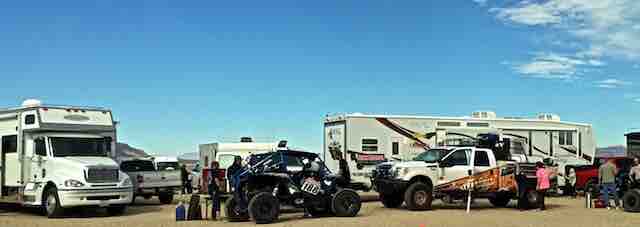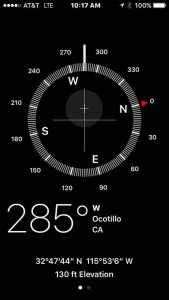
Greetings from Ocotillo, California
.
.
From the travels and adventures of the
“World’s #1 Trackchaser”
.
.
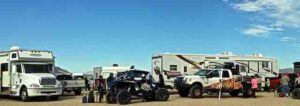
Plaster City West
Dirt road course
Lifetime Track 2,193
THE EVENT

Today’s undertaking was just one of more than 2,000 trips that have taken me up, down and around the long and dusty trackchasing trail. If you would like to see where I’ve been and experience those adventures here’s the link:
If you’ve got a question, comment or whatever please leave it at the bottom of this report. It’s very easy to do. I’ll try my best to respond. Thanks!
ON THE WAY TO THE RACES
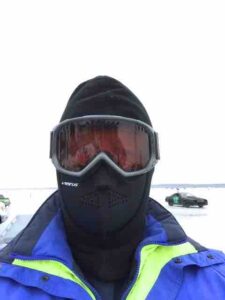
Not what I would normally being doing in January.
This is January. It’s late January. Normally if I were trackchasing in January you would find me standing on a frozen lake somewhere in the Upper Midwest or Canada.
Today was the exact opposite of what I normally would be doing in January. The temperature hovered around 80 degrees. I was not standing on a frozen lake. I was standing in the middle of the California dessert. I was standing on sand and not ice.
Ocotillo here we come.
Today Carol and I ventured down to Ocotillo, California which is just west of Plaster City, California. Plaster City is about 150 miles southeast of our home in San Clemente. It’s only a few miles from the Mexican border. If you weren’t going to use the name Ocotillo in the track’s location and Ocotillo was west of Plaster City what would the description be? How about “Plaster City West”.
A new discovery for me.
Just about six weeks ago I had discovered both the Road Runner Motorcycle Club and the AMA Off-Road Division. These guys and gals primarily focus on motorcycles and to a somewhat lesser degree quads. However during the past year or so they have added UTVs aka SXSs (side by sides) to their racing agenda.
Not your father’s quarter-mile bullring.
Carol and I had come today to see the SXSs race on a 12-mile course just to the west of Plaster City, California. The track is aptly named “Plaster City West”.
Dan’s my contact.
My main contact with the Road Runner Motorcycle Club has been Dan Barker. Dan first gave me the lowdown on the club’s activity before our first visit in December 2015.
Recall that Dan gave Carol and me the use of his “RZR” pronounced “Razor” at the last event. No, we weren’t shaving. A RZR is an off-road four-wheel race machine. “RZR” is a brand name from the off-road manufacturer Polaris. We had an absolute blast driving than RZR. Dan offered us the opportunity to use his machine again today.

So what did Carol think?
I ran it by Carol. She looked as me as said or seemed to say, “Are you #$^%#^ crazy?” Of course she doesn’t TALK like that but sometimes she gives me LOOKS like that.
“My neck was sore for a week after that last ride. I had to hold my hat up during the entire 11-mile drive.” I got the message. It didn’t seem like a good time to remind her it wasn’t a “hat” but a helmet. Net, no RZR ride for us today.

Gary Jacob is the leading California trackchaser.
You may or may not know that I am not the #1 trackchaser in the state of California. Right now that honor goes to Gary Jacob. Gary died nearly ten years ago. He left this earth after seeing 149 Golden state tracks.
I hold a #1 ranking in 19 different states. However my current total of 146 California tracks gives me only a #2 ranking in my home state. After today my total is now just two shy of Gary’s total at 147.

I have a series of trackchasing goals I hope to achieve in 2016.
Yes, I have a series of trackchasing goals for my 2016 trackchasing season. One of those goals is to become California’s #1 trackchaser. The Road Runner Motorcycle Club and the AMA District 38 Off-Road division will be and have been integral parts of my moving upward in the California rankings.
By the way if you would like to see a complete list of my 2016 trackchasing goals here’s the link to them from my website:
During 2016 these folks will race at seven venues in total. They are all located, seemingly, in a 25-mile radius circle. Today’s location, “Plaster City West” was about 8-10 miles from last month’s race location in the Superstition Mountains. After seeing these two races there are five different locations that AMA District 38 will visit in 2016 that I have not seen.
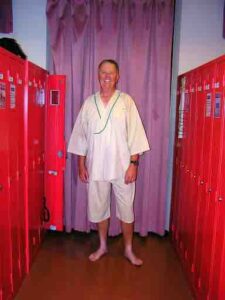
“Randy Rules” make trackchasing just a bit more challenging for me.
Trackchasing rules proposers has seen fit to implement several “Randy Rules” to stop or at least try to slow down my assault on the trackchasing record books. Here are just a few of the rules that were implemented and can legitimately be called “Randy Rules”.
Randy Rules.
This followed one of my trackchasing visits to New York:
“all temporary tracks of the same type are only separately countable if they physically exist and are active at the same time, even if they are located on different parts of the property (moving a temporary track during the course of the day does not constitute a new track)”
This followed one of my trackchasing visits to Indiana:
“Any racing event in which the shape of the course is not predetermined, and/or may change from lap to lap, can not be used to count a track. These events include, but are not limited to, Hound & Hare events.”
This followed one of my trackchasing visits to the California desert:
“Any event where racers start at various intervals rather than simultaneously is not countable.”
The shifting sands of trackchasing rules.
Yes, I think you would agree that folks can get pretty “active” with the rules after I go trackchasing! Don’t worry. It doesn’t bother me. I’m used to it.
I long ago learned “they just can’t help themselves” as my grandmother used to say.
I guess you can say my fellow competitors just can’t help themselves. Trackchasing is a very competitive hobby. If it were not why do you think the above rules were proposed and then approved?
The rule changes were not proposed out of the thin air. They were implemented right after I did something that FOLLOWED the rules but that the trackchasing political hierarchy didn’t LIKE. When they didn’t like me following the rules they wrote they changed the rules.
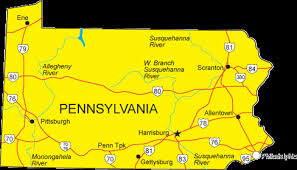
It’s a Pennsylvania thing.
Trackchasing started out mainly as a “Pennsylvania thing”. There were a couple of other state residents involved but the formation of the hobby was mainly initiated by Keystone state residents. None of the founding fathers were from California. As a matter of fact none of trackchasing’s founding fathers lived west of the Eastern time zone!
What’s next?
The next potential “Randy Rule” might very well come from the following current trackchasing rule,
“Multiple tracks of the same type (types being divided into ovals, road courses and figure eights), located at the same facility, are countable under the following conditions: connected ovals or figure eights are separately countable only if they exist and are active at the same time; disconnected, permanent ovals or figure eights (located on separate areas of the facility) are separately countable whether or not they exist at the same time; all temporary tracks of the same type are only separately countable if they physically exist and are active at the same time, even if they are located on different parts of the property (moving a temporary track during the course of the day does not constitute a new track), with the following exception, tracks located inside different buildings on the same property can be counted separately; all tracks falling under the road course category are only separately countable if they are not connected or if they meet the change of surface rule, with the following exception, one permanent and one temporary road course which share a minority of common surface may be counted twice.”
What is the “same facility”?
The above rule seems to focus on tracks that are located within the same “facility”. I would hope that no one considers The Imperial Valley, which is in the Colorado Desert, which is an extension of the larger Sonoran Desert a single “facility”. Even if you lived in Pennsylvania you couldn’t think that could you?

The tracks the Road Runner Motorcycle Club and the AMA District 38 Off-Road division races on are not your “father’s stock car” tracks of the 50s and 60s. Times change. What happened ten years ago or twenty years ago or 50 years ago is not the way the world is today. Just reach into your pocket and look at your cellphone to prove that point.
What do we know?
What do we know about the AMA District 38 Off-Road Division tracks? First they are desert off-road race layouts. They are long. The two I have seen so far were eleven and twelve miles in length respectively. The surface is dirt or more precisely sand. These are “road courses” in trackchasing parlance. Drivers have to turn both right and left.
These are temporary tracks. Each time a race is held the track has to be “surveyed” to mark the trail. The Bureau of Land Management has to approve the track’s configuration. This is about the best description of the desert track situation I can give.
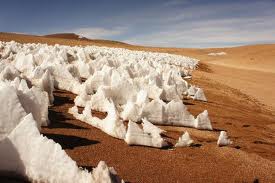
Are ice tracks like desert tracks?
I guess one might consider ice racing track locations to have some similarity to these desert tracks. Ice races are held on frozen lakes and rivers. As I understand it an ice race might be in one place on the lake this week and could conceivably move a short distance, i.e. yards the next week based upon ice conditions etc.
If I saw an ice race in one location this week and then next week they moved the “track” a block or two from the first location I would not count the track a second time. The rules don’t say how far an ice track can “move” from one location to the next in order for the racing to count twice.
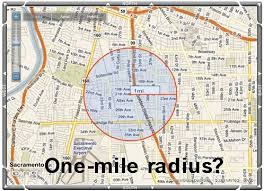
The “one-mile” minimum.
For my tastes I used ONE MILE as the minimum requirement. If they race on Lake Superior this week and then move the track to somewhere else on Lake Superior that is at least a mile away then that’s good enough for me. In that example I’ve seen racing on two tracks.
I don’t think it would be fair to say that once you’ve seen an ice race at one location on Lake Superior you can never ever seen ANOTHER ice racetrack on Lake Superior. Lake Superior covers 31,700 square miles. It’s roughly 350 miles by 160 miles in size. The lake borders multiple states.
The Sonoran Desert covers about 100,000 square miles. That’s three times the size of the largest Great Lake, Lake Superior. It covers large parts of Arizona and California and several states in the country of Mexico.
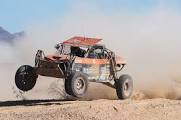
Yes. They tried to stop desert racing.
There are no rules that cover how far one temporary desert track should be from the next one. I think when trackchasing’s political elite put in the “everybody had to start the race at the same time” they thought they were putting a stop to desert racing as a countable venue in trackchasing forever! Folks there are not many deserts in Pennsylvania.
The “standard” for desert tracks.
I will use the same standard with desert tracks as I have with ice tracks. What is that standard? One mile. If one desert track, or ice track for that matter is at least one mile from the next then I will count each track separately. As mentioned I was told the track I saw with this group in December, “Superstition Mountain” was 8-10 miles from today’s race location at Plaster City West.
Plaster City.
Plaster City is an unincorporated community in Imperial County in the U.S. state of California. It is located 17 miles west of El Centro, at an elevation of 105 feet. United States Gypsum operates a large gypsum quarry and plant there and owns the town. That’s right. They OWN the town.
THE RACING
Plaster City West – Plaster City, California
Saturdays are the day for me.
There was no admission charge for spectators at today’s racing. Saturday is reserved for UTV racing. On Sundays the motorcycles and quads race. Today’s dirt road course, using trackchasing’s definitions, was 12.5 miles long. Sunday’s course will be twice as long. The difficulty will be much greater as well. The motorcycles can navigate tougher terrain than the UTVs.
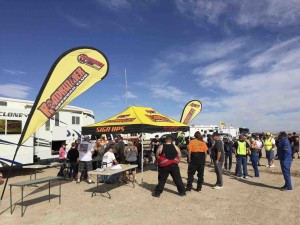
Drivers and riders.
Carol and I were in time for the driver’s meeting. Had we come to the race tomorrow the meeting would have been called the “rider’s meeting”. UTVs have drivers; motorcycles and quads have riders.
My first time to “drop the banner”.
In the past I have stood in the flag stand to start a few events. Probably my highest profile race, where I waved the green flag, was at the Atlanta Motor Speedway.
In this type of racing they don’t start the race with a green flag. Yes, I told you this wasn’t “your father’s stock car racing”. Then how DO they start the race?
A large banner, about four feet wide and 2-3 feet tall, is held up by two people. The race director gives the command to the people holding the banner. When the command is given the banner is lowered to the ground and off the UTV racers go.
Today I was invited by race referee Dan Barker to help him hold the banner. Steve Fenton was today’s race director. Steve used his watch for the countdown. At the exact second when the time reached 11 a.m. the banner was dropped. I TOLD you this wasn’t “Your father’s stock car racing”. For the UTV/motorcycle fans this is a reference to short track oval racing’s notorious reputation for not starting on time.
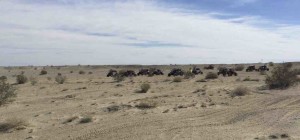
Thirteen drivers were facing a 12-mile desert off-road racing course.
Today there were thirteen UTV entries racing across three divisions. Most, if not all, drivers had a navigator along for the ride.
You’ve probably all seen the old movies where settlers use a “land rush” start to race across the open land in search of free land they can open to settlement. That’s what today’s start looked like.
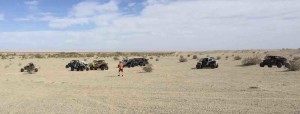
The start.
There were two rows of racers today in the three divisions. The first row, received the banner drop and then about thirty seconds later the banner fell for the second row.
If all of today’s racers had been in ONE class a start like this would not have allowed me to count this race for trackchasing purposes. Remember one of the “Randy Rules”? All racers must start the race at the same time. Really, what is meant by that is that all racers in a single CLASS must start the race at the same time.
Countable cars and countable drivers.
Here’s another somewhat strange interpretation of the rules of trackchasing. There are countable cars and there are countable drivers. However there are countable cars that can be raced without a countable driver. There are also countable drivers that can race cars that don’t count in trackchasing.

Say what?
Permit me to explain. I suspect that more than a few people may be scratching their heads and saying, “Randy, what WERE the people thinking who made up the rules of trackchasing?” I can understand the potential confusion. I’ll repeat myself on one important point. I did not come up with the rules. I was never asked for my input on the initial rules, which make up 90% of the current total trackchasing rules package.
What is a countable driver?
In reality a countable driver is any person who is 18 years of age or older. In trackchasing we call a person who meets that criteria an “adult”. Stop me if I am going to fast for anyone. Any class that is open to people 18 years of age or older counts in trackchasing. Here’s an important point. A class may be OPEN to adults but an adult does not have to be in the race.
That’s right. A class may be open to racers who are 15 years and older, as an example. In this example there may be twenty drivers in the race. They might all be 15 years old. However, it is because the class is OPEN to adults that makes it countable regardless of where any adults were actually in the race.
The above is a good rule.
There are several trackchasing rules that I take issue with. However, I think the above interpretation is a good one. It’s a lot easier to understand what the track rules are, in this case knowing the class is open to racers 15 years and older than it is to check birth certificates.
What is a countable racing machine?
The above tells you what a “countable” driver is. So what is a countable racing machine? Essentially it is any car* or truck*. Of course the previous sentence comes with an asterisk.
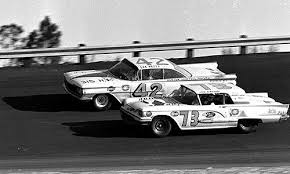
What’s a car?
Yes, “cars and trucks” do count. However, there are lot of different definitions of “cars” in racing. Of course a 1959 T-Bird like the one driven to second place by Johnny Beauchamp (#73 above) in the inaugural Daytona 500 was a car. They likely bought it at a new car dealership and stripped it down, put a cage in it and went racing.
However, there are several “purpose built” racing machines that are considered cars as well. Racers like sprint cars and midgets and more recently all tubular chassis machines are considered race “cars”.
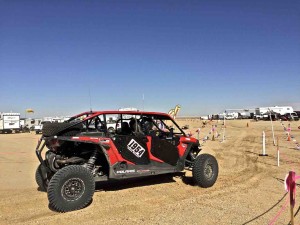
Oval track racing fans may or may not know that UTVs, which are sometimes called “side by sides” are considered “cars” as well. ATVs, often times called Quads are not considered cars. Of course we all know motorcycles, boats, three-wheelers and the like are not cars. Somewhat surprising to me is that “flat” go-karts are not considered cars in the world of trackchasing.
I don’t even want to go here.
I don’t want to even address the issue of “Reliant Robins”. The Reliant Robin was first manufactured in Tamworth, England. For a time these folks were the second biggest manufacturer of cars in England. Reliant Robins have been a countable class in trackchasing for years. That proves that a “car” does not have to have four wheels. The Reliant Robin is a “three-wheeled” car!!

So what makes a car different from machines that are not cars?
So what makes a car different than a motorcycle or a three-wheeler or whatever? It apparently is not the number of wheels. The only other real difference I can see that separates a car from another kind of machine that doesn’t count in trackchasing is the steering wheel. Just about every other thing a car has lots of “non-countable” trackchasing machines have. Yes, I guess it’s the steering wheel.
I have agreed to abide by current trackchasing rules.
No, I do not agree with all of the rules of trackchasing. I especially don’t agree with the “Randy Rules” that have been added after the fact. However, I have agreed to abide by all of the current trackchasing rules.
What is the real advantage of having a single set of rules?
Why have trackchasing rules at all? The answer is really pretty simple. Trackchasing is a very competitive hobby. Why do you think they keep score in sports? Competitors and fans want to know who WON! Trackchasing rules allow people to keep SCORE. When a score is kept people can figure out who WON.
Here’s another advantage to having a single rules package. It’s related to keeping score and winning as well.
Comparing.
With a single set of rules one can compare their trackchasing track totals to someone else’s who is also using the same set of rules.
For the longest time, and I’m sure this is still true today, some folks had a hard “mental” time accepting the overall trackchasing rules. They liked to count their track totals with the rules “package” THEY had used in their minds forever. There’s nothing wrong with that.
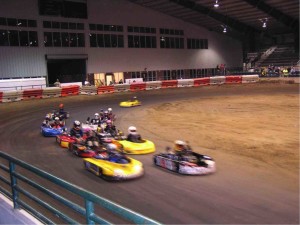
However, if you are a trackchaser who wanted to count flat karts in your totals, by way of example, you really couldn’t compare your track totals with someone who didn’t count flat karts. Some trackchasers from day one wanted to count or not count certain situations that others did or did not want to count.
Having just one set of “official” rules would allow any worldwide trackchaser to compare his or her totals with others using the same package. I have often commented on, some might say criticized, the rules our founding father’s came up with. In my opinion some are a bit hokey. The “Randy Rules”, which cannot be laid on the doorstep of trackchasing’s founding fathers, are double hokey. However, it should be noted that several of the “Randy Rules” advocates were founding fathers.
I like this part.
The one aspect of having a standard set of rules is that it does allow one trackchaser to compare his or her results with others who count their tracks with that set of rules. I like that.
Whew!
That right. Whew! How did we get that deep into that subject? Remember? Carol and I were out in the Sonoran dessert for a late morning of UTV racing. Let’s get on with it.
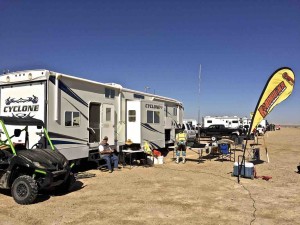
Not so much for spectators.
Off-road dessert racing is not much of a spectator sport. Once the drivers drove a few hundred yards over a ridge they were out of our sight from our paddock area viewing position.
Today’s course was 12.5 miles long. We saw them race for a few hundred yards at the start. Then at times we could barely seem them kicking up dust in the far distance. When the drivers came past the main check point we could see them from about a half-mile out. No, this type of racing is not for spectators who watch from the paddock area.
A six-lapper.
Today’s race was a six-lapper. At your hometown little dirt bullring a six-lap heat race might last a minute and a half. Today a single lap took the drivers about twenty minutes to complete. The entire UTV race would last about two hours.
We did spend some time talking to one of the flaggers. His job was to warn the racers to slow down for the checkpoint. I believe there were four other checkpoints out on the course itself. Although there were fluorescent markers about every 100 yards on the course the checkpoints insure nobody takes a “short cut”.
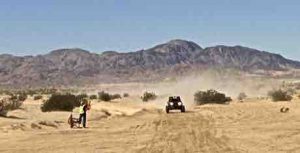
These guys are hardcore racers.
The flagger we spoke with was a lifetime motorcycle rider. At 55 years of age he was still going strong after riding bikes for some 48 years of his life. He told us that just last month he had an accident. He ended up flying over the handlebars of his motorcycle at a speed of 65 M.P.H. I would not want to do the “55/65”. Would you?
A very windy desert.
Today the wind blew strongly. The winds must have been in the 25-30 MPH category. Luckily the temperature was nearly 80 degrees. I would hate to have been out here if it were 50 degrees with those winds. I was told that all of these events are rain or shine. We don’t get all that much rain in the Southern California deserts but that was good to know for my future planning.
Carol and I were able to fully explore the paddock area. Don’t miss my photo album to see what today’s event looked like.
AFTER THE RACES
This is a local track for us.
Attending one of these “local” events, even though it did require 4-5 hours of round-trip driving, is a nice alternative to hitting the airports. I’m sure I’ll be back as I continues to add to my existing trackchasing total in California of 147.
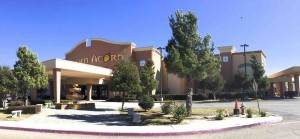
What is a “Golden Acorn”.
On the way home Carol and I stopped for a late lunch at the Golden Acorn Casino in Campo, California. The casino is only about 30 minutes from today’s race location.
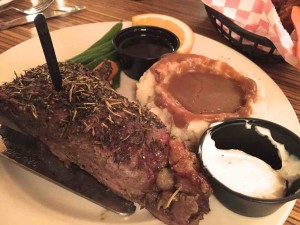
What was the attraction of this casino? They advertised a prime rib dinner for $7.77. Would the food be any good? It was excellent. We will definitely stop here again.
The casino is located on the Campo Indian reservation. The Campo Indian Reservation is home to the Campo Band of Diegueno Mission Indians, also known as the Campo Kumeyaay Nation, a federally recognized tribe of Kumeyaay people in the southern Laguna Mountains, in eastern San Diego County, California. The reservation was founded in 1893 and is 16,512 acres large.
From there we headed back to San Clemente. An El Nino winter storm was on the way. We wanted to beat that rainy weather back to San Clemente and we did.

Thanks!!
Thanks very much to Dan Barker and the Road Runner Motorcycle Club for their hospitality. They are a nice bunch of folks. We’ll be back.
Good afternoon.
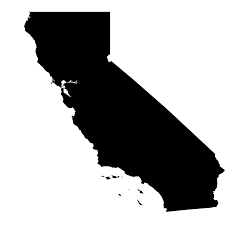
California
The Golden state
This afternoon I saw my 147th lifetime track in the Golden state, yes the Golden state. I’ve seen more tracks in California than any other state.
Thanks for reading about my trackchasing,
Randy Lewis
World’s #1 Trackchaser
Peoria Old Timers Racing Club (P.O.R.C.) Hall of Fame Member
California definitions: “Minutes”
A measure of distance.
How far is that? “15 minutes from here.” Does he live far? “Yeah, like an hour away.” Is it nearby? “Yeah, like two minutes.”
It’s just how we measure distance. It also varies depending on time of day. Sometimes directions have to be given “with traffic” and “without.” It’s one of those California things.
QUICK FACTS
AIRPLANE
No airplanes!
RENTAL CAR
No rental cars
PERSONAL CAR
San Clemente, CA – trip begins
Plaster City, CA
San Clemente, CA – trip ends – 294 miles
Total air miles – 0 (0 flights)
Total rental car miles – 0 (0 cars)
Total personal car miles – 294 (1 car)
Total miles traveled on this trip – 294 miles
TRACK ADMISSION PRICES:
Plaster City West – No charge
Total racetrack admissions for the trip – $0
LIFETIME TRACKCHASER COMPARISONS
The three most important trackchasing comparisons to me are:
Total lifetime tracks seen
Total “trackchasing countries” seen
Lifetime National Geographic Diversity results
Total Lifetime Tracks
There are no trackchasers currently within 525 tracks of my lifetime total. Don’t blame me.
- Randy Lewis, San Clemente, California – 2,193

Total Trackchasing Countries
There are no trackchasers currently within 10 countries of my lifetime total.
- Randy Lewis, San Clemente, California – 70
Current lifetime National Geographic Diversity results
- Randy Lewis, San Clemente, California – 4.47
That’s all folks! Official end of the RLR – Randy Lewis Racing Trackchaser Report
Click on the link below to see the “Video Plus” production from the racing action today.
Click on the link below for a photo album from today’s trackchasing day. You can view the album slide by slide or click on the “slide show” icon for a self-guided tour of today’s trackchasing adventure.
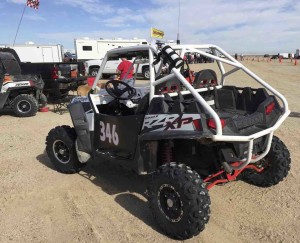
Plaster City West SXS racing with the Roadrunner Offroad Motorcycle Club

